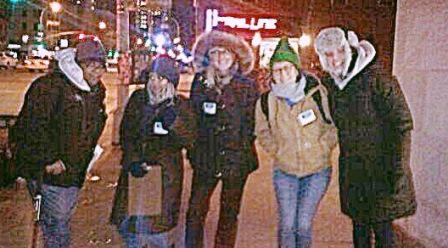
The HOPE count is an essential survey that helps guide the Manhattan Outreach Consortium’s (MOC) outreach strategies. The MOC – Goddard Riverside’s homeless outreach program – has teams on the streets 24/7 and covers the entire borough of Manhattan. A large part of MOC’s duties include responding to 311 calls for homeless sightings, as well as assessing “hot spots” and “encampment areas” that are known for homeless activity. On a regular basis, MOC uses various tracking tools to assess changes, new findings and trends in homeless activity. The HOPE count greatly contributes to our data analysis, as it provides us with statistics compiled through on-foot canvassing. It also captures sightings in parks, subways, NYCHA building grounds and other hard to reach areas. The HOPE count data strengthens MOC’s ability to assess homeless trends throughout Manhattan. We use these findings to determine what areas require increased outreach efforts, as well as what areas have decreased in homeless activity. The demographic information gathered during the HOPE count is also crucial, as it provides an even further breakdown of Manhattan’s homeless population.
On the night of this year’s HOPE count, I arrived at PS 41 located at 116 W 11th street around 10:30 p.m. and was assigned as team leader for Sector 21. We were responsible for canvassing 23rd St and 9th to 29th St and 11th Avenues in a grid format going from east to west. A few minutes after reviewing our maps, I was approached by a lieutenant from the 6th precinct. He introduced me to the two officers that would be canvassing with us. This was my third HOPE count and I had never canvassed with police, so I found this exciting.
We left around 11:50 p.m. and arrived at the corner of 23rd & 9th ave where the officers met us (they were not allowed to transport us to the destination so we travelled separately). The weather was extremely cold and we all wore multiple layers of clothing, well aware of the temperature dipping as low as 10 degrees that night. We snapped a few group pictures, took out our first map and designated duties for following the maps, documenting the surveys and conducting the surveys. We rotated duties for each map so everyone got to participate in the full process. During our canvassing we only encountered one individual we believed to be homeless. He reported having a place to stay that night but was very disheveled and was going through trash cans. We engaged 17 individuals that we assessed as not homeless. Some individuals did not want to engage and walked past us quickly. However, we were able to get most of these individuals to tell us if they were homeless, where they were sleeping tonight, if they were veterans and if anyone else had surveyed them that night. Most were in a rush due to the cold and we got better responses by asking questions quickly as they walked along side us, instead of reading the entire survey verbatim. We encountered a few individuals from the neighborhood that were interested in the HOPE count, thanked us for engaging them and taking the time do conduct such a survey. The police officers were very patient with our surveying and walked closely behind us the entire night. I asked one of the officers why they thought our area required escorts as it seemed to be a generally safe area. The officers strongly believed it was due to us canvassing around NYCHA buildings in the area. I found this interesting as last year my group canvassed NYCHA buildings in the LES and did not have police escorts. We had to actually walk through the NYCHA grounds, engaging individuals walking through the complexes. This year we merely canvassed the outside blocks which we were well lit and had very little activity. Our group felt perhaps the escorts were required more so because of the isolated blocks of warehouses around the high line which were poorly lit, had construction/scaffolding areas with random warehouses active with workers unloading trucks.
We finished our count at approximately 1:45 a.m. and headed back to PS 41 where we handed in our data. We talked about our findings on our way back and felt the cold weather significantly impacted the amount of street homeless individuals (and individuals in general) that we encountered. We agreed it was a good sign that the homeless likely sought shelter indoors (hospitals, shelters, drop-ins and subways). However, we are eager to learn of the survey results in the subways and how it compared to the street level. As MOC outreach workers, we are all curious to see if our street outreach and housing placements are decreasing the homeless population in Manhattan.
The HOPE count this year was another interesting and unique experience for me. Canvassing on foot, on one of the coldest nights of the year, during the most accurate time of night to encounter street homeless individuals is what MOC’s outreach work entails. It felt like second nature to me and it reminded me how dedicated we all are to ending homelessness in NYC. I felt a sense of pride knowing my city takes so much time and effort to organize such an enormous project each year. Seeing the hundreds of volunteers at PS 41 was a powerful sight to see. I imagined the thousands of other volunteers conducting the exact survey, at the exact same time, in the exact cold weather, throughout the 5 boroughs! Every street, park and subway is canvassed which is an incredible task if you really think about it.
Everyone counts. One night only. Make it count…and that’s just what we did!
– Christina Narine
Program Director, MOC, Special Initiatives